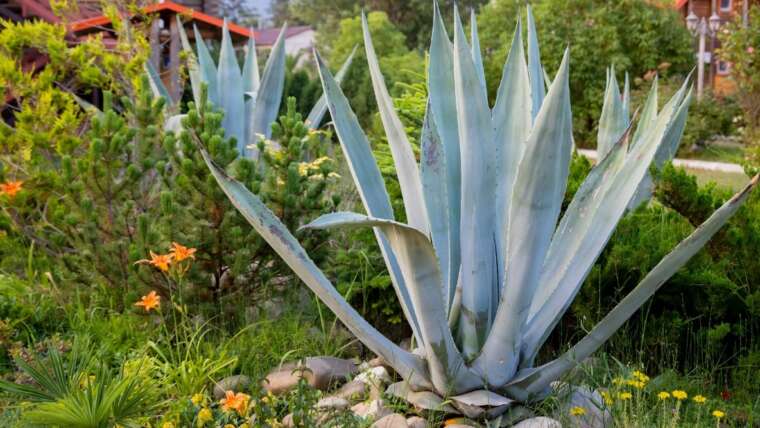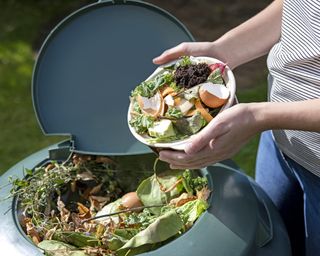Ornamental grass is sometimes underrated in the gardening world, but as climates shift, they have earned their keep among gardeners and landscapers. They are workhorses that add luscious visual interest, airiness, and height required to have a textually interesting and dynamic garden. Plus, ornamental grasses are very low-maintenance and easy to prune.
Some varieties form cute little clumps, while others get tall enough to serve as highly effective privacy fences. When cared for properly, perennial grasses return year after year, requiring very little from you, and most are drought-resistant once established to boot.
Prune your grasses annually with just a few supplies. Depending on the height and type of your grass, you’ll need sharp shears, pruning scissors, hedge trimmers, or a weed-whacker. Twine or rope is optional. It keeps your grass bunched together while you prune, and the whole process takes very little time.
Let’s get into how to properly prune your ornamental grasses to keep them healthy and productive for seasons to come.
Step 1: Identify the Variety
When and how to prune ornamental grasses depends on the type and variety. It’s important to know what you’re dealing with so you can prune properly. It’s also a little bit of personal preference. There are three distinct types that all have different pruning requirements.
Three Types of Ornamental Grasses
Proper pruning begins with identifying your ornamental grass as a sedge, warm-season grass, or cool-season grass.
Evergreen Sedges
Often mistaken for grass, sedges belong to the Sedge and Carex families, offering versatility in warm and cool weather.
These look like and are often mistaken for grass, but they’re not classified as such. Rather, they are in the Sedge (Cyperaceae) family of grasslike herbaceous plants. They are primarily evergreen and versatile for warm or cool weather. The easiest way to decipher sedges from grasses is with this poetic pneumonic:
Sedges have edges,
Rushes are round
Grasses have nodes from their tips to the ground.
In other words, the leaves of sedges are solid and three-sided. They don’t have any joints along the stem.
Warm-Season Grasses
 Pampas grass is a warm-season ornamental grass with feathery plumes that add a textural element to landscapes.
Pampas grass is a warm-season ornamental grass with feathery plumes that add a textural element to landscapes.
True grasses are members of the Poaceae family. Warm-weather grasses are sometimes called “southern grasses.” These grasses lay dormant until late summer, when their flowering begins. If left un-pruned, you may recognize these as straw-like, brown, or dead-looking blades throughout the winter months.
Southern grasses grow up to 15 feet in height. ‘Pampas Grass’ is a popular semi-evergreen grass beloved for its fluffy appearance and long-lasting blooms. But in many regions, such as California, pampas grass can be super invasive. For this reason, it’s important to plant a sterile seedless variety.
Note that some warm and cool-season grasses are semi-evergreen, meaning they keep their color and don’t go fully dormant in winter, where temperatures remain mild. Be sure to fully research your variety to learn how best to care for it.
Cool-Season Grasses
 Blue fescue, a cool-season ornamental grass, features compact, blue-green tufts, providing a striking accent in garden landscapes.
Blue fescue, a cool-season ornamental grass, features compact, blue-green tufts, providing a striking accent in garden landscapes.
These grasses grow in spring and fall when the temperatures are mild and the soil is moist. Flowering begins in June in most regions. They mature quickly, and their growth slows or halts in peak summer.
Cool-season grasses are short, usually maturing at just about eight to ten inches. However, an outlier in this category is ‘Feather Reed Grass’ (Calamagrostis), which can grow to be five feet in height. ‘Tufted Hair Grass’ is a great cool-season, semi-evergreen option for containers, urban gardens, and small spaces, whereas ‘Giant Feather Grass’ is a light, tall, and airy option that prefers mild conditions all year long.
‘Blue Fescue’ (short) and ‘Karl Foerster Grass’ (tall) are popular cool-season grasses in northern landscapes.
Step 2: Get the Timing Right
 Delay pruning until late winter or spring for benefits like insulation, wildlife habitat, and plant rejuvenation.
Delay pruning until late winter or spring for benefits like insulation, wildlife habitat, and plant rejuvenation.
Some growers don’t prefer the look of tall, floppy grasses in their winter garden, so they cut them down in the fall after flowering. In northern zones, perennial grasses go dormant during the coldest part of winter, leaving dried seed heads and fallen leaves.
However, don’t underestimate their ability to beautify a space in cold regions. The shorter, spiky varieties look interesting and add a funky flair to a garden even after a light snowfall.
Here are some benefits of waiting to prune until spring:
- In colder growing zones, the drooped grass insulates the vulnerable crown of the plant.
- Seed heads serve as a food source for a wide range of wildlife in the dead of winter when it’s crucial and hard to come by.
- Deer and small critters may use tall grasses as a resting, hiding, or bedding area.
- If you prune too early in fall, and experience a sudden spike in temperatures, plants may be triggered to send up new growth that is wasted energy when heading into winter.
- Heavy pruning in late spring freshens up your plant, ridding it of any damage that harsh winter weather or extreme summer heat caused and encourages new growth.
Wait until late winter or early spring to prune unless you live in a particularly dry and windy area where dead leaves and branches are a fire hazard. Dried leaves and brush burn extremely easily and can be dangerous if left in the garden.
Based on the type of grass, follow the recommended timing for pruning:
Most evergreen ornamental sedges don’t require pruning because they mature at a short height and remain short, although trimming away occasional dead or brown leaves will keep them looking tidy. This can be done at any time of year. Cut back no more than a third of the plant.
Prune warm-season grasses in late fall or mid-late spring. The right cold-hardy grasses provide your garden with seasonal interest and can be left as-is until spring.
Prune these in late winter or early spring. This will give you the benefit of crown protection through the winter and help jumpstart new growth in spring.
Step 3: Bundle ‘Em Up
 Optionally tie up warm-season grasses before pruning for control and an even cut line.
Optionally tie up warm-season grasses before pruning for control and an even cut line.
This step is optional and will mostly be used when pruning warm-season grasses, simply due to their height. If you grow cool-season grasses that remain short, you can skip to Step 4.
Tying up your grass will give you a bit more control and help you get a nice, even cut line. Think of it like putting hair into a ponytail before chopping it off. The elastic band is used as a cut guide. Optionally, use twine or heavy rope, depending on your grass type and size. You may have to tie the grass up in several places if it’s very tall. This also allows you to follow the natural shape of the plant as you prune. New growth follows this shape, requiring less maintenance throughout the growing season.
If cutting or hedge-trimming, bunch the grass together and tie twine or rope around it tightly, four to eight inches from the ground. Weed-whacking might be a little more difficult to control the shape of the prune with this method, but you can go back and fix up the shape afterward. Don’t go too low, or you may tangle the twine up in your machine.
Pro tip: Some grasses have sharp edges and might slice your hands when handled bare-handed, so thick leather gloves and long sleeves are good protection.
Step 4: Cut ‘Em Down
 Prune annually using hedge trimmers for thick grasses or shearing scissors for light trimming.
Prune annually using hedge trimmers for thick grasses or shearing scissors for light trimming.
It’s recommended to prune ornamental grasses once annually and divide your plants once every five years for the best performance. Hedge trimmers work best on thick grasses because they can handle more per cut, whereas shearing scissors work best for light trimming.
Evergreen sedges: As I mentioned earlier, most evergreens won’t need pruning. However, an occasional clean-up won’t hurt. Sedges, in particular, do not like to be over-pruned, so you’re just going for a light trim here. Sometimes, even a gentle raking to remove any dead or dried-up foliage does the trick.
Warm-season grasses and evergreen grasses (if needed): Following the plant’s shape as best as you can, cut the grass just below your twine. If you didn’t use twine, cut about three to six inches from the ground. Some varieties can be cut to the ground.
Cool-season grasses: When cutting these back, leave at least ⅓ of the plant remaining. Cutting more can severely damage or kill the plant.
Pro tip: Your general spring clean-up and annual feed can happen at this time as well. However, dividing both warm and cool-season grasses should only happen when they are actively growing but outside their flowering window. Division of evergreens should only be done in spring. If split just before winter, they may not survive since they do not have a dormant period.
Step 5: Clean Up, Compost, and Enjoy!
 Use trimmed ornamental grass as compost or mulch, ensuring seedheads are removed to prevent unintentional seed spread.
Use trimmed ornamental grass as compost or mulch, ensuring seedheads are removed to prevent unintentional seed spread.
Take your trimmings to the compost, or better yet, use them as mulch in your spring vegetable garden! Just be sure to remove the seedheads beforehand so you don’t unintentionally spread grass seeds all over your garden. Rake around the base of your trimmed plants to remove any straggling leaves that have fallen.
When done right, pruned ornamental grasses will come back every year for two to six years. Dividing and transplanting new plants keeps your garden lush as old plants die off and new plants take over and thrive.
Frequently Asked Questions
It’s not uncommon for grasses to be left un-pruned. Although they may be fine, they may not look as aesthetically pleasing. With proper pruning, they’ll look nicer and there’s reduced risk of spreading to unwanted areas. The spring foliage has an easier time growing from freshened tips.
Cool-season grasses can be irreversibly over-pruned, so only prune off about ⅔ of the plant. More than this causes poor performance or death.
Final Thoughts
Select the right ornamental grass for your region and garden needs. Prune them properly based on the type, and you’ll be enjoying them for years to come.




